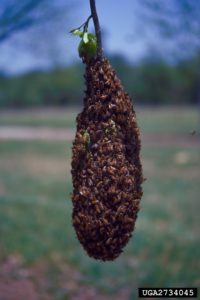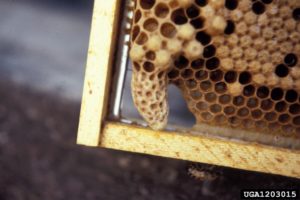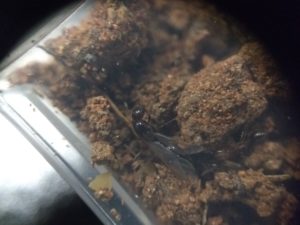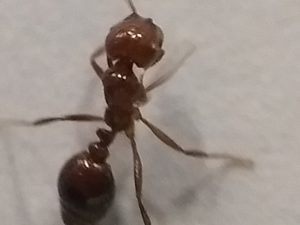Bee Swarms & Fire Ants Q&A
go.ncsu.edu/readext?524681
en Español / em Português
El inglés es el idioma de control de esta página. En la medida en que haya algún conflicto entre la traducción al inglés y la traducción, el inglés prevalece.
Al hacer clic en el enlace de traducción se activa un servicio de traducción gratuito para convertir la página al español. Al igual que con cualquier traducción por Internet, la conversión no es sensible al contexto y puede que no traduzca el texto en su significado original. NC State Extension no garantiza la exactitud del texto traducido. Por favor, tenga en cuenta que algunas aplicaciones y/o servicios pueden no funcionar como se espera cuando se traducen.
Português
Inglês é o idioma de controle desta página. Na medida que haja algum conflito entre o texto original em Inglês e a tradução, o Inglês prevalece.
Ao clicar no link de tradução, um serviço gratuito de tradução será ativado para converter a página para o Português. Como em qualquer tradução pela internet, a conversão não é sensivel ao contexto e pode não ocorrer a tradução para o significado orginal. O serviço de Extensão da Carolina do Norte (NC State Extension) não garante a exatidão do texto traduzido. Por favor, observe que algumas funções ou serviços podem não funcionar como esperado após a tradução.
English
English is the controlling language of this page. To the extent there is any conflict between the English text and the translation, English controls.
Clicking on the translation link activates a free translation service to convert the page to Spanish. As with any Internet translation, the conversion is not context-sensitive and may not translate the text to its original meaning. NC State Extension does not guarantee the accuracy of the translated text. Please note that some applications and/or services may not function as expected when translated.
Collapse ▲I think spring is finally here to stay. And with the warmer weather comes some interesting insect questions. I thought I would share two of these questions. I hope you find these questions and their answers helpful.
Question: Why do honey bees swarm?
Answer: A swarm of honey bees is just the insect colony’s way to split and search for a new home. Swarming is how honey bees start new colonies.
When a swarm occurs, a queen bee leaves the nest with about two-thirds of the hive’s worker population.

A queen bee and worker bees form a hanging cluster as they wait for scout bees to locate a new home for this swarm. image credit G. Keith Douce, University of Georgia, Bugwood.org
Once outside the hive, the bees will congregate on a branch or some other object and form a hanging cluster. Then scout bees go out and search for a new suitable home for the colony.
Swarming bees are not normally aggressive. However, it is best to avoid getting too close to swarming bees if you are allergic to bees or have a fear of them.
The old colony left behind is inherited by a newly formed daughter queen. Since this old colony is only one-third of its former strength, it is relatively small and weak. However, they do have the benefit of an established home. This small hive works to rebuild it strength/numbers.
Swarms normally occur in spring and early summer. Bees are more likely to swarm when they feel crowded or the hive has poor ventilation.
Swarming is also more likely as the queen ages. As the queen gets older, she produces less and less queen pheromone.

This peanut-shaped structure is called a queen cell. This cell indicates that this colony may swarm. image credit Carl Dennis, Auburn University, Bugwood.org
Pheromones are important chemical communication signals in the hive. There are several of these communications chemicals that are produced by bees.
The queen pheromone attracts workers from a short distance, and causes them to lick and antennate the queen in a “retinue response”. The workers in the retinue thus pick up the pheromone and spread it throughout the colony. If workers don’t receive enough of the queen’s pheromone, they start raising new queen bee. Swarming is part of this natural queen-raising process by the colony.
If you see a swarm of honey bees, you can contact the Caldwell Extension Center at (828)757-1290 and we can share contact information of local beekeepers that can collect the swarm and give it a good home. They have informational bee meetings on the third Thursday of each month at 6:30 p.m.
Question: I found fire ants in my pasture. What should I do to control them?
Answer: Red imported fire ants (RIFA) are appearing in Caldwell County. Until last fall, there were no fire ants in Caldwell County that I was aware of. Through their natural spreading habit they have arrived in Caldwell County.
Fire ants are now another new insect that is making Caldwell County its home. Fire ants will be added to the growing list of invasive pests that have appeared during my career in Caldwell County. This partial list includes brown marmorated stink bugs, hemlock wooly adelgid, palmer amaranth, ambrosia beetles, glyphosate resistant ryegrass, and kudzu bugs.
I had hoped red imported fire ants would not have arrived during my lifetime in Caldwell County.

This is a winged female red imported fire ant. She has the ability to fly and start a new colony. She was captured in Caldwell County this spring. Image credit Seth Nagy
Unfortunately, the reality is they are here, like it or not. The good news is they can be “managed”, but this does take time and money.
The management options for red imported fire ants in pastures and hay fields is to use a poison bait or a mound insecticide drench. A third option is to combine these two approaches into the “two-step method” where bait is applied, and then mound drenching is used 7 to 14 days later. The drench is used for mounds that are in high traffic locations or sensitive areas.
The baits work well, but they don’t work fast. Baits containing hydramethylnon (Amdro Pro), pyriproxyfen (Esteem), (s)-methoprene (Extinguish), or a mixture of hydramethylnon and (s)-methoprene (Extinguish Plus) are currently labeled for use in cattle pastures. In addition, Award Fire Ant Bait (containing fenoxycarb) can be applied to horse pastures.
Individual fire ant mounds can be treated by drenching with a mixture of insecticide and water.

Red important fire ants are aggressive. This fire ant was collected in Caldwell and is waking up after being put to sleep with rubbing alcohol. Fire ant workers vary in size from 1 mm up to 6 mm. Image credit Seth Nagy
This is poured into and around the mound to saturate and kill the ants by direct contact. Currently only carbaryl (Sevin 4F, Sevin XLR, and Sevin 80S, that are labeled for use in pastures) is legal for use in pastures.
Fire ant baits currently available for pasture and hay fields work well when applied according to label instructions. The key to using baits is patience. If you use a bait product and apply it properly, a broadcast application should give 80% to 95% control.
Fire ant bait application tips:
- Make sure the bait is fresh (less than a year old).
- Apply when ants are foraging for food (when temperatures are 65 to 90 degrees F).
- Apply when there is no chance of rain for at least four hours.
- Always read and follow label directions.
For answers to your agricultural questions, call the Caldwell County Extension Center at 828-757-1290 or visit us online anytime.




